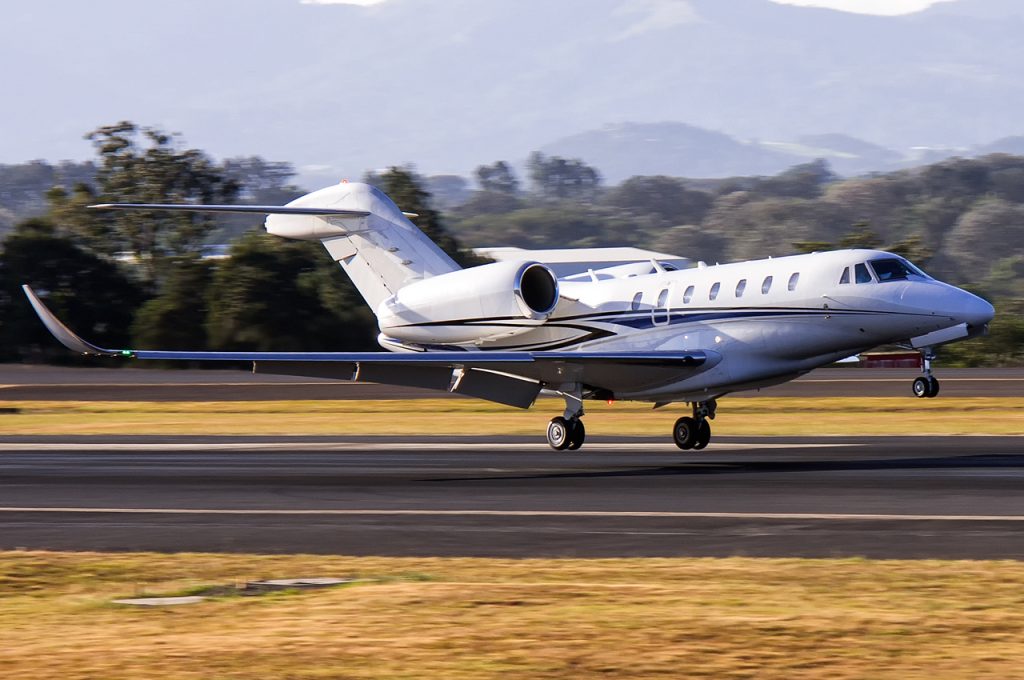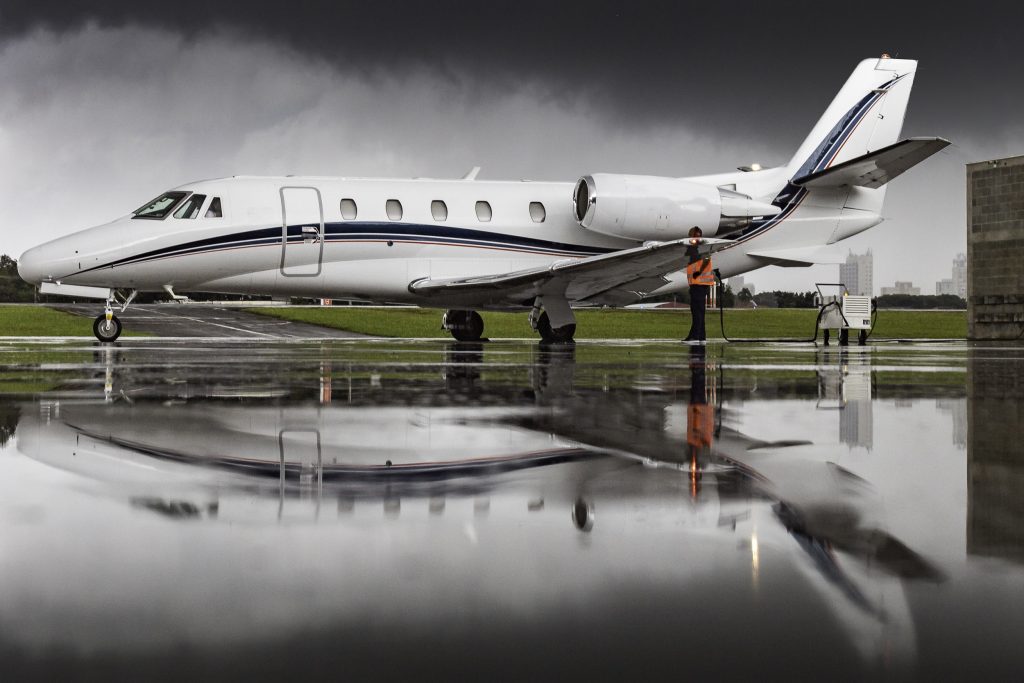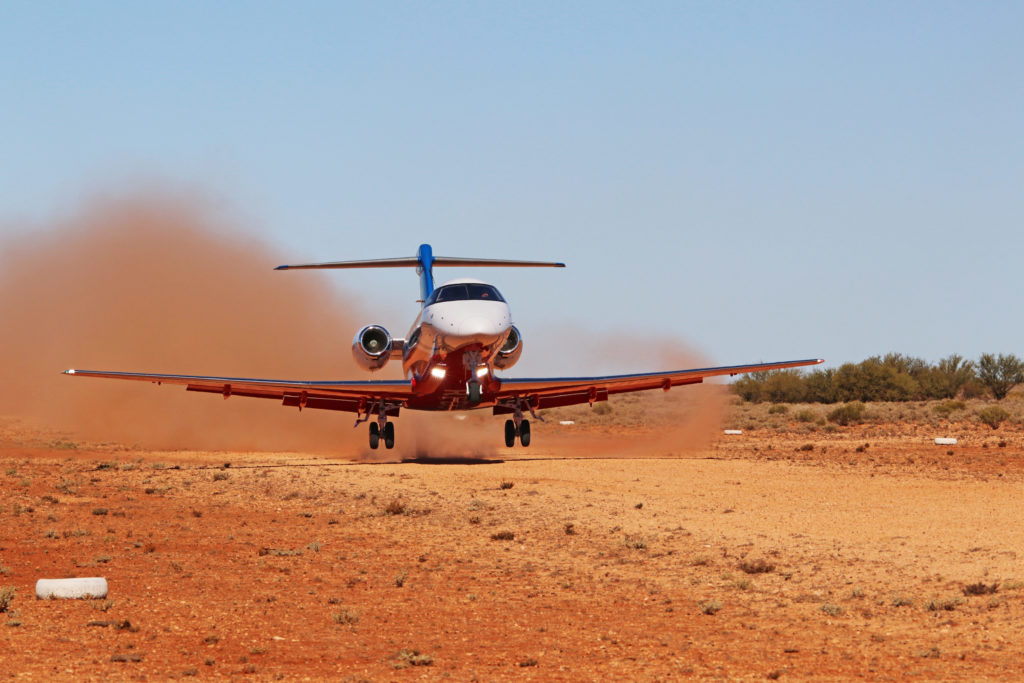Switch to:
 EN
EN  Português (PT)
Português (PT)  Español (ES)
Español (ES)
Executive jets have always permeated the popular imagination as expensive and inaccessible “toys”. Currently, the reality is different: little by little, private aircraft or those belonging to air taxis have left behind the stigma of being extravagant objects, and are finally starting to be seen according to their real functions. This happened especially thanks to the development of new possibilities within the aviation universe – like with the accessibility allowed by Flapper, bringing this segment of private aviation to an increasing portion of society. With that, several myths started to be broken. Shall we examine some of them?
Myth #1: Executive Planes Are Too Slow

When faced with smaller aircraft — compared to those used by regular airlines — we can even imagine that the reduced size makes flights slower. But know that this is not always true!
The greatest proof of the speed provided by executive jets is in one of the most disruptive models ever launched in executive aviation: the Cessna Citation X. Able to fly at 51,000 feet at a speed of Mach .93 (equivalent to 93% of the speed of the sound), it still ranks as the fastest business jet ever developed in the industry. If we compare the performance of the Citation X to one of the most used models in regular aviation, the Airbus A320, we have a clear idea of the differences: the A320 flies at a maximum of 39,000 feet, at a maximum speed of Mach .82 (82% of the speed of sound).
Myth #2: You Must Know Executive Aviation In-Depth Before You Can Use It
If this was necessary in the past, but today it is no longer necessary. That’s why Flapper exists: to bring you, the air transport user, closer to all the benefits that only executive aviation can provide.
Through an intuitive platform, whether through our website or our smartphone apps (Android and iOS), booking a flight to any destination of your choice is very easy and fast. With just a few clicks it is possible to complete all the necessary steps so that your trip is really within reach.
In addition to making reservations easy, we offer all information about the available aircraft, even the technical details of each one. Thus, you will be able to know in advance everything you will experience on board the available aircraft!
Myth #3: Only People with High Earnings Can Use Executive Aviation

The democratization of executive aviation is also one of the strongest pillars of action here at Flapper. And this goal is achieved daily with great mastery! Proof of this are our Empty Legs: with affordable prices and easy booking, flights between the main Brazilian cities on the best aircraft in our portfolio are available daily to all our customers.
In some cases, these opportunities are even more affordable compared to the prices offered by regular airlines for the same segment to be flown at similar times. Thousands of customers have already tested and approved our last minute opportunities and finally discovered just how magnificent the world of executive aviation is.
Myth #4: Executive Jets Are Not Safe
Brazil, through RBAC (Brazilian Civil Aviation Regulation) nº 135 of ANAC (National Civil Aviation Agency), regulates the activity of air taxi companies in Brazil with enormous technical rigor. In addition, over the last few years, ANAC has intensified regulatory and supervisory work with operators, resulting in increasingly safer flights for air transport users.
Currently, with the expansion of requirements coming from the regulatory authority, executive aviation in Brazil is experiencing levels of requirement comparable to those of regular airlines. All this translates into reliability, safety, and even more comfort. You can rest assured: using executive aviation is safe!
Myth #5: Air Taxi Planes Can’t Fly in Bad Weather

Executive jets have the same technologies that are embedded in the most renowned commercial airliners. In some cases, the technological apparatus is even more robust by choice of operators, given the circumstances of flights in air taxis that pass through airports with different characteristics on a constant basis.
In addition to embedded technology, there are also countless similarities in the preparation of airline pilots in terms of crew training. All instrument flight license and rating requirements are exactly the same. This makes flight safety and quality comparable between the two segments, giving air taxi operators the same flexibility and flight capacity. Rain or shine, with safety to take off, both executive and regular aviation will fly.
Myth #6: Executive Aviation is the Enemy of Environmental Preservation
Quite the opposite! Among the various segments of aviation, air taxi operators are the most numerous in efforts to reduce harmful emissions, especially for the adoption of new technologies that can mitigate the use of fossil fuels in air activity. Business jets were, until the middle of the last decade, responsible for 0.2% of the total carbon emissions in all flights carried out around the world.
Flapper is proof of this: in an effort to increasingly comply with the most appropriate sustainability practices in aviation, we are committed to zero carbon emissions by 2030, further expressing all the innovative characteristics present in the company’s DNA. On January 25, 2022, Flapper signed an LOI (Letter of Intent) with Jaunt Air Mobility, an aerospace company based in Texas, USA, for the purchase of 25 vertical take-off and landing (eVTOL) aircraft. The aircraft are 100% electric, powered by batteries and completely independent of the use of non-renewable fuels.
Myth #7: Boarding and Disembarkation Procedures in Executive Aviation Are More Bureaucratic

Regular users of air transport know how exhausting it is to follow all the protocols required at airports: an hour and a half before check-in, endless lines for security inspections and x-rays, disorganized lines for boarding… with a maxim to take effect: “aviation is the best means of transport for those who are not in a hurry”.
In executive aviation, the process is reversed: when using private aviation, boarding takes place in a private hangar with great comfort and efficiency. In addition to waiting in a calm and silent environment, you will not face queues. After being invited to board, it only takes a few minutes for the aircraft’s engines to start and the flight begins. There is nothing comparable to the time saving provided by executive aviation!
Myth #8: Executive Aviation Has No Social Character
The flights of air taxi companies are not always aimed at the public with higher purchasing power. Many planes take off daily with a very noble mission: to transport lives in need of immediate medical assistance. This is the role played by companies specializing in aeromedical transport.
In this modality, aircraft used to transport passengers are quickly converted into true aerial ICUs, allowing the removal of sick people for recovery close to their families, or people in need of medical care of reference in large capitals. These processes, unfortunately, are not adopted on regular flights due to the complexity of adapting the planes. With this, saving lives makes executive aviation have an even more special role.
Myth #9: Business Planes Don’t Fly To Many Destinations

In fact, what happens is exactly the opposite: if a destination is not served by regular aviation, it can be perfectly served by business aircraft. While in some cases a passenger’s real destination is far from the airport where the aircraft will land, executive aviation provides the experience of being able to land and take off from the necessary location. This provides, once again, for unparalleled efficiency .
Myth #10: Executive Planes Have Restrictions at Major Airports
Executive aviation aircraft have specially equipped hangars to handle departures and arrivals. Furthermore, the airspace is made so that different aircraft, of different categories, can fly in an orderly, coordinated, and safe way. In this case, there is no restriction that prevents the operation of executive aircraft at airports.
What happens is that in some cases, such as at Congonhas Airport in São Paulo, arrivals and departures need to be coordinated through operating “slots”, previously required by the aeronautical authorities. This measure is adopted so that the flow between airline aircraft and non-scheduled executive aircraft is optimized, avoiding inconvenience in the services provided to these aircraft.
